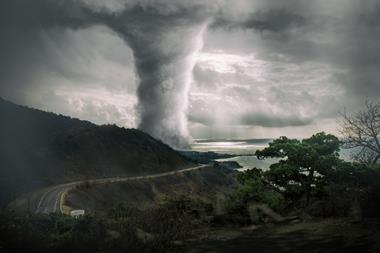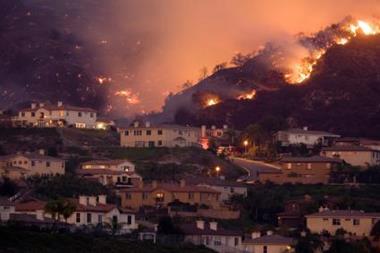The entire East and Gulf Coasts of the United States are subject to hurricane damage, but some places are especially vulnerable.
The International Hurricane Research Center (IHRC) used a matrix consisting of 12 factors to evaluate the vulnerability of US mainland areas to hurricanes, shown in Table 1. The primary determinants of vulnerability to hurricanes are cyclonic energy (hurricane frequency and storm intensity) and defence failure (levees or dikes). Therefore, the subtotal is the product of these three factors.
Hurricane frequency was scaled for each area according to the number of landfalls during the period of record (1850 to 2006), and storm intensity was gauged relative to the largest size hurricane experienced in that area.
Wind destruction of houses and other buildings accounts for the majority of the physical damage, except in the case of Hurricane Katrina’s breaching of the New Orleans levees in 2005.
Mitigation or otherwise
It has often been said that there are only two types of levees — those that have failed and those that will fail in the future. Levees/dikes in hurricane prone areas provide a false sense of security; the US Army Corps of Engineers builds levees and dikes only to a certain level of protection, typically to withstand a Category 3 hurricane, based on a cost-benefit ratio.
New Orleans and the Lake Okeechobee communities are vulnerable to a much greater extent than elsewhere. The New Orleans levees have now been restored but only so that the city has about the same level of vulnerability as before hurricane Katrina in 2005. These levees have failed over 20 times historically, with Hurricane Betsy in 1965 flooding about 80% of the city just as Katrina did.
About 40,000 people live in small communities, like Belle Glade, on the southern end of Lake Okeechobee in Palm Beach County, Florida. A hurricane in 1928 broke the levees, and over 2,500 people were drowned by the wall of water that flowed southward. Category 2 Hurricane Wilma in 2005 resulted in considerable erosion of the sedimentary dike by wave action, causing leakage. Our modelling has shown that the Herbert Hoover Dike around the lake is subject to breaching during times of high water and the passage of a Category 4 hurricane. South Florida has been in drought conditions for the past 18 months so lake levels are very low, but Lake Okeechobee could well be the next hurricane disaster.
Storm surge is the most life threatening hurricane hazard; the Galveston, Texas, hurricane of 1900 took 8,000 lives. The Galveston seawall has been effective in preventing such disasters since then, but storm surge flooding of this low lying island is still a major concern.
The most vulnerable area in the United States to surge inundation is coastal Mississippi, which is virtually ordained to suffer monster sea water floods. The funnel shape of the coastline as defined by Louisiana’s Chandelier Islands and the Mississippi mainland shore, as well as the very shallow water of Mississippi Sound make this area susceptible to exceptionally high surges. Category 5 Camille in 1969 generated a nearly 7m surge in Pass Christian, Mississippi, causing enormous damage to coastal property and considerable loss of life.
Hurricane Katrina set a new record with a 10m surge in Waveland, near Bay St. Louis, Mississippi. While Katrina was barely a Category 4 hurricane, it was much larger in overall size than Camille, which accounts for the higher surge. Nothing along the Mississippi coast for a few hundred metres inland is really safe from the bulldozing effect of storm surges with superimposed, hurricane forced waves.
Building codes
Building codes are the most important consideration in terms of preventing wind, water, and structural damage overall. Miami-Dade and Broward Counties in South Florida have the strongest building codes in the country with a high velocity hurricane zone within the Florida Building Code. The panhandle of Florida has embraced the full extent of the Florida Building Code in the wake of the damaging hurricanes of 2004 and 2005 and the subsequent windstorm insurance crisis.
North Carolina adopted a much better building code than its neighbors after the devastation of Category 3 Hurricane Hazel in 1954, and New York and New Jersey are generally credited with having good building codes. The Texas Windstorm Insurance Association has adopted one of the strongest codes in the United States, but it is only used when wind insurance is provided through the state.
Louisiana only adopted strong, statewide building codes after Katrina, which accounts for the exfoliation of the Superdome roof when only subjected to a Category 1 wind field.
While Mississippi adopted its first building codes after Katrina, they only include some
coastal counties.
Table 2 provides the current status of state adoption of the International Building and Residential Codes developed by the US based International Code Council.
Freshwater flooding
The public has only fully recognised the hazard of freshwater flooding in the past decade. Hurricane Floyd in 1999 caused a 500 year flooding event, inundating large areas of coastal North Carolina with $6 billion in losses.
Tropical Storm Allison in 2001 clearly demonstrated that no correlation is necessary between storm strength and the amount of rainfall and freshwater flooding.
Downtown Houston received 100cm of rainfall in a few days. The Texas Medical Center, the largest medical center in the world, was flooded to depths of 3m in places. South Florida, like Houston and its surrounding area, is also very flat, so that the water stacks up, rather than running off quickly.
Human issues
A major socioeconomic factor is population at risk, which includes not only the total number of people living in the area, but also the percentage who are poor, elderly or both. Many of these people do not have vehicles or are difficult to move, as was painfully obvious in New Orleans after Katrina. New York City leads in numbers at risk with its population of 8 million, followed by Galveston/Houston and Miami/Ft. Lauderdale with about 4 million each, and Long Island at 2.8 million. Tourism swells the numbers in the Florida Keys and New Orleans. Although New Orleans has lost about half its residents, poverty is still a major problem. Miami also has a large population living at poverty level, as well as over 300,000 aged 65+ years. The St. Petersburg/Tampa area has about 2 million residents, of whom about a quarter in St. Petersburg are 65 or older.
Evacuation is a critical issue, especially for people living on islands subject to storm surge inundation. Evacuation time is a function of the distance to the mainland and routes available. By virtue of geography, the Florida Keys and Cape Hatteras, North Carolina, are the most difficult to evacuate quickly because each is served by only one, largely two lane road.
Evacuation of New Orleans and Galveston/Houston are also problematic, as grimly demonstrated by Hurricanes Katrina and Rita in 2005. The sleeper is the St. Petersburg/Tampa area. It has not been directly hit by a hurricane since 1921, yet vast areas are only a few feet above sea level, it is subject to large storm surges and high ground is many miles inland over low causeways.
Values at risk
Florida and New York lead the way for insured coastal property at more than $1.9 trillion each (Table 3). Mid and high rise condominiums, hotels and businesses are rapidly coming to dominate the so-called gold coast of Florida from Palm Beach to Miami. The vulnerability is enormous as South Florida is the number one strike area in the continental United States.
The second US gold coast is the Hamptons in eastern Long Island, which is often on the most damaging, right hand side of hurricanes during landfalls. The 1938 hurricane produced a 5m storm tide that cut scores of inlets and pancaked large sections of the barrier beaches, where today there are homes valued in the tens of millions each.
Economic development in the Galveston/ Houston and St. Petersburg/Tampa development corridors is also enormous, and the IHRC catastrophe model indicates that a Category 5 hurricane could inflict over $100 billion in damages on this Florida Gulf coast metropolitan area.
Local and state capability to prepare for and respond to hurricanes is difficult to measure. The Department of Homeland Security (DHS) analysis uses a complicated score card that rates cities’ and states’ plans for evacuations, shelters, medical care, and other emergency procedures and priorities. Florida was the only state to meet all of the DHS basic requirements for planning and dealing with hurricane catastrophes.
Florida displayed its resolve and capability well during the 2004 hurricane season when the state was struck by four hurricanes in 44 days. In fact, it sustained eight hurricane strikes within an 18 month period of 2004 and 2005 and performed exceptionally well overall.
Other “sufficient” states include New York, Texas, and North Carolina. Not surprisingly, Louisiana was rated as “not sufficient.”
Coastal erosion is an important issue for people living on barrier islands. Beaches and sand dunes serve as the first line of storm protection. Fortunately, South Beach in Miami is very wide with a well established and vegetated sand dune, which provides good
protection. Cape Hatteras is particularly susceptible to storms because of the high erosion rates and narrow barrier width; Hurricane Isabel in 2003 cut an inlet near Hatteras Village. There is also considerable development packed on barrier beaches in the Wilmington and St. Petersburg areas.
The results
Florida dominates the list with four out of the ten most vulnerable areas, with Palm Beach coming in at number 11. This is predictable because of its long shoreline that includes both the Atlantic and Gulf Coasts as well as the prevailing pathway of hurricanes toward South Florida that originate off the west coast of Africa and those moving northward in the Gulf that often impact the Florida panhandle.
Redevelopment of large areas of New Orleans that are many feet below sea level is fraught with problems, as is beachfront development in coastal Mississippi, which is subject to huge storm surges. New York City is often on the list of hot spots for hurricane catastrophes, because the shorelines of Long Island and New Jersey could funnel a large surge into Manhattan if affected by a major hurricane. However, the possibility of this happening is very remote; there is no record of hurricanes making landfall in northern New Jersey, and the New York City area has a single Category 1 hurricane in the last 150 years.
Postscript
Stephen Leatherman is the We Will Rebuild Chair professor and director of the International Hurricane Research Center in Miami, Florida.
Email: Leatherm@fiu.edu;
Website: www.ihrc.fiu.edu.
Acknowledgments: Ping Zhu and Sergio Sejas assisted the author with the hurricane meteorology. Shahid Hamid provided information from the IHRC catastrophe model, and Keqi Zhang and Chengyou Xiao conducted the Hurricane Katrina and Lake Okeechobee storm surge analyses.


















